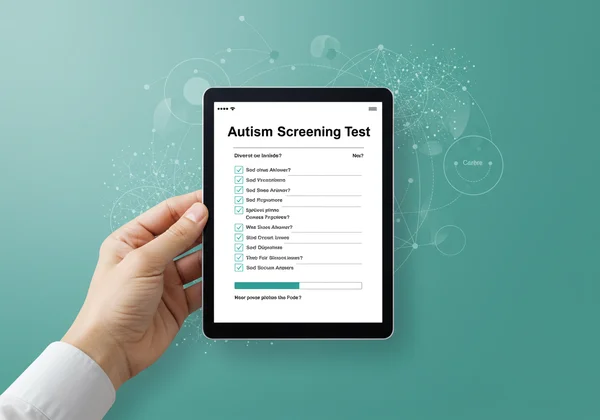Autism in Students: Classroom Signs & Educator Guide
As an educator, you are in a unique position to observe the subtle, day-to-day interactions and learning patterns of your students. You notice when a child excels, when they struggle, and when their behavior seems different from their peers. For students on the autism spectrum, the classroom can be a world of overwhelming sensory input and confusing social rules. Recognizing the signs of Autism in Students is the first step toward creating a supportive learning environment where every child can thrive. What are the early signs of autism that might appear in a school setting?
This guide is designed to empower you with the knowledge to identify potential signs of autism, communicate compassionately with parents, and understand the role of preliminary screening tools. By fostering understanding and taking responsible next steps, you can become a crucial partner in a student’s journey of discovery and support. An excellent starting point for gathering initial insights is a reliable screening tool.

Recognizing Classroom Autism Signs: What to Look For
Autism Spectrum Disorder (ASD) presents differently in every individual. The signs can range from obvious to incredibly subtle, especially in students who have learned to "mask" their traits. As an educator, focus on patterns of behavior over time rather than isolated incidents.
Early Indicators of Autism in Young Students
In preschool and early elementary students, the signs often relate to developmental milestones. You might observe a student who avoids eye contact or doesn't respond to their name consistently. They may not engage in pretend play with others, preferring to line up toys or focus intensely on a single object. Other developmental flags include delayed speech or a lack of gesturing, such as pointing or waving.
Social & Communication Differences in Autistic Learners
Social interaction is a common area of challenge. An autistic student might struggle to initiate or maintain conversations with peers. They may interpret language very literally, missing sarcasm, jokes, or idioms. You might also notice they have difficulty understanding non-verbal cues like facial expressions or body language. While they may desire friendships, they often lack the intuitive tools to build them in a typical way.
Repetitive Behaviors & Sensory Sensitivities
Repetitive movements, often called "stimming," are a hallmark of autism and serve as a self-soothing mechanism. This can include hand-flapping, rocking, or spinning. A strong need for routine and predictability is also common; unexpected changes to the schedule can cause significant distress. Furthermore, many autistic students experience intense sensory sensitivities, finding classroom lights too bright, background noise overwhelming, or certain textures unbearable.

Responsible Next Steps: Leveraging Online Autism Screening Tools
Observing potential signs is one thing; knowing what to do with that information is another. Your role is not to diagnose, but to gather information and guide parents toward professional resources. This is where a reliable online screening can be an invaluable, confidential first step.
Understanding the Role of Online Autism Screening
It is crucial to understand the difference between a screening and a diagnosis. An online autism test is a preliminary tool designed to identify traits associated with ASD. It is not a medical diagnosis. Think of it as a well-organized questionnaire that helps structure your observations into a clearer picture. The results can indicate whether a formal evaluation by a qualified professional, like a developmental pediatrician or psychologist, is warranted. When you need a trustworthy starting point, consider using an online autism test.

When to Consider an Online Screening Tool
If you have consistently observed a pattern of signs that affect a student's learning or social integration, an online screening can be a helpful step. It can provide parents with a concrete, private way to explore their concerns before committing to a potentially lengthy and expensive professional assessment. Sharing a resource like a free autism test can empower parents with information, helping them feel more prepared to speak with a doctor.
Compassionate Communication: Talking to Parents About Autism Concerns
Broaching the topic of autism with a parent requires immense sensitivity and care. This conversation should be approached as a collaborative partnership focused on the student's well-being.
Preparing for the Conversation: Key Points & Resources
Before the meeting, document specific, objective observations. Instead of saying "He's antisocial," try "I've noticed that during group activities, he often plays by himself and seems distressed by loud noises." Prepare a list of resources, including information on professional evaluation services and preliminary tools like an autism spectrum test. Frame the conversation around support and understanding.
Emphasizing Support, Not Diagnosis
Start the conversation by highlighting the student's strengths. Reiterate that your observations are simply that—observations from your professional perspective in the classroom. Clearly state that you are not diagnosing their child. The goal is to work together to understand the student's needs better and explore ways to help them succeed. This collaborative approach builds trust and opens the door for productive next steps.
Strategies for Supporting Autistic Students in the Classroom
Whether a student has a formal diagnosis or not, you can implement strategies to create a more inclusive and supportive classroom. Many of these practices, rooted in universal design for learning, benefit all students.
Creating an Inclusive and Predictable Environment
Structure and routine are comforting for many autistic students. Provide a visual schedule for the day's activities and give advance warning before transitions. Minimize sensory overload by offering noise-canceling headphones, creating a quiet corner in the classroom, or dimming harsh fluorescent lights. A predictable environment reduces anxiety and frees up cognitive resources for learning.

Fostering Strengths and Individualized Learning
Focus on a student's strengths and interests. Many autistic individuals have deep, passionate interests in specific topics. Incorporate these "special interests" into learning activities to boost engagement. Provide clear, concise instructions, breaking down large tasks into smaller, manageable steps. Adopting a strengths-based approach helps build confidence and shows the student they are valued for who they are. These insights can sometimes be highlighted in a personalized report after an autism screening test.
Partnering for Progress: Supporting Every Student
As an educator, your role in supporting neurodivergent students is profound. By learning to recognize the signs of autism, using resources responsibly, and communicating with empathy, you create a classroom where every student feels safe and understood. You are a vital bridge between the student's daily experience and the support systems that can help them flourish.
Remember, the journey begins with observation and understanding. If your observations have raised questions, taking a structured approach to gathering information is a responsible next step. Encourage parents to explore tools that can provide preliminary insights and guide them toward professional help. To learn more or to use a reliable screening tool, start your test today.
Frequently Asked Questions for Educators on Student Autism
What are the earliest signs of autism an educator might observe? In young children, the earliest signs often involve social communication. This can include a lack of response to their name, minimal eye contact, not sharing enjoyment by pointing at objects of interest, and delays in speech and language development. They may also show a preference for solitary play over interacting with peers.
How can educators ethically recommend further assessment for a student? The most ethical approach is to present your observations factually and without judgment. Schedule a private meeting with parents and share specific, non-diagnostic examples of what you've seen in the classroom. Frame it as a partnership to support their child's success and suggest they speak with their pediatrician or a child development specialist. You can also offer resources, like a link to a confidential online screening, as a low-pressure first step for them to explore privately.
What is the difference between an online autism screening and a professional diagnosis? An online screening is a preliminary questionnaire that identifies the presence and severity of autism-related traits. It provides a score or an indication of likelihood but is not a diagnosis. A professional diagnosis is a comprehensive evaluation conducted by a qualified healthcare provider (like a psychologist or psychiatrist) involving clinical observation, interviews with parents, and standardized assessments. The screening is a first step; the diagnosis is the official clinical conclusion.
Can a student be autistic without showing obvious signs in the classroom? Yes, absolutely. This is particularly common in girls and students with high linguistic or cognitive abilities. They may engage in "masking" or "camouflaging," which involves actively suppressing autistic traits and mimicking the social behavior of their neurotypical peers. This is mentally exhausting and can lead to burnout, anxiety, or depression, even if the student appears to be coping well on the surface.